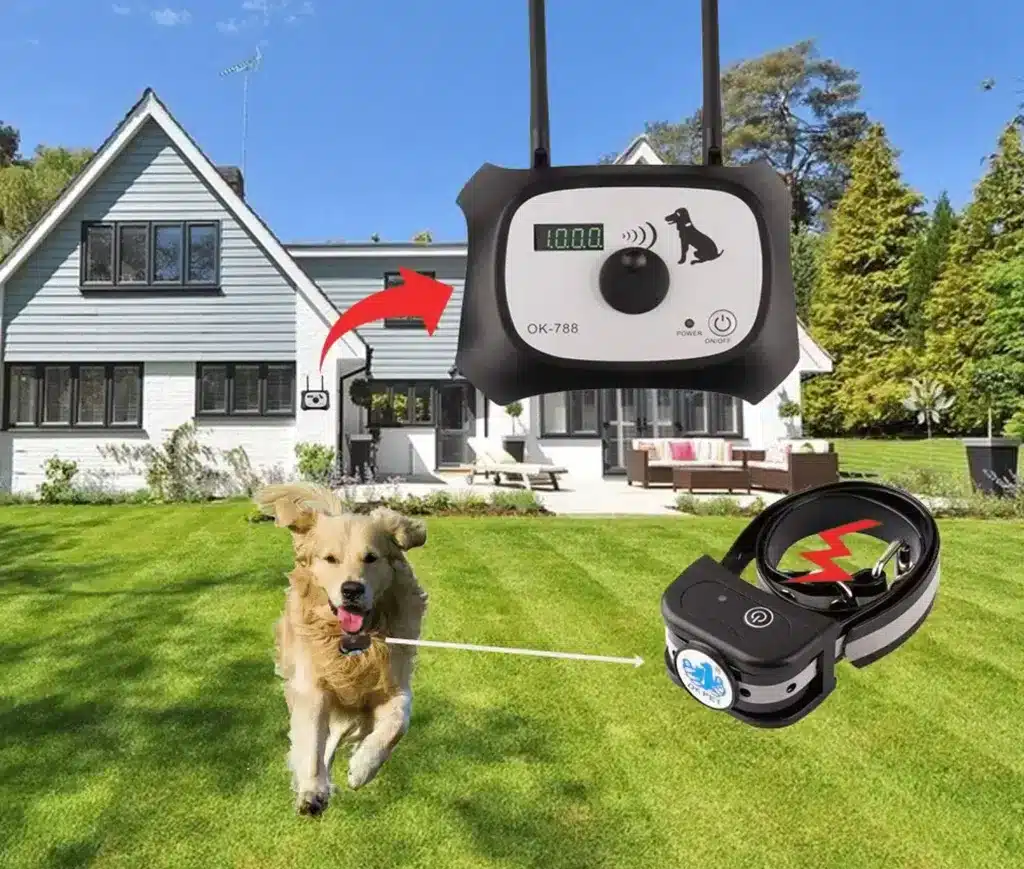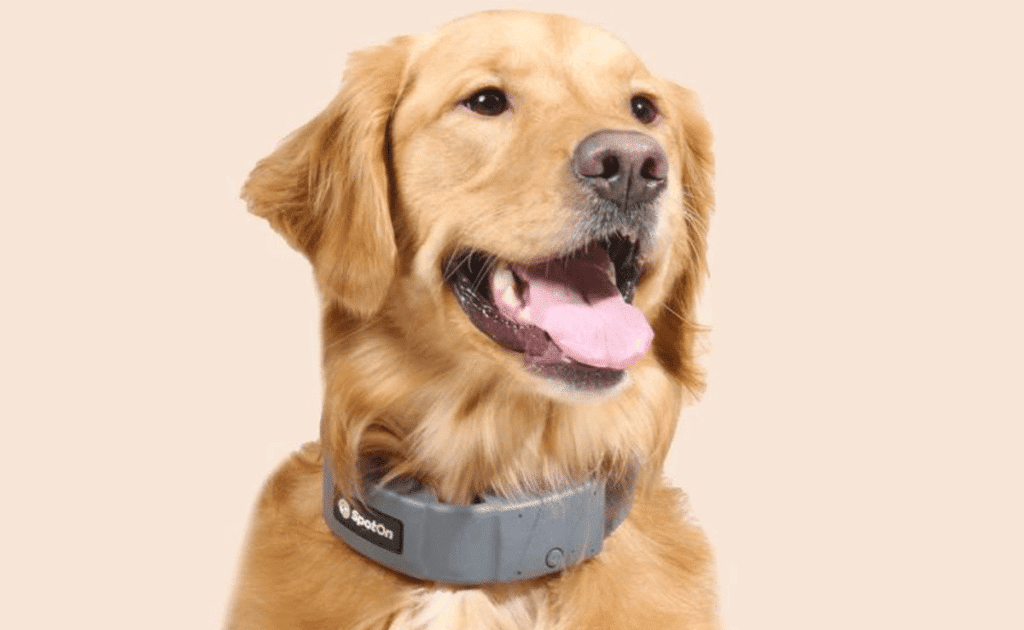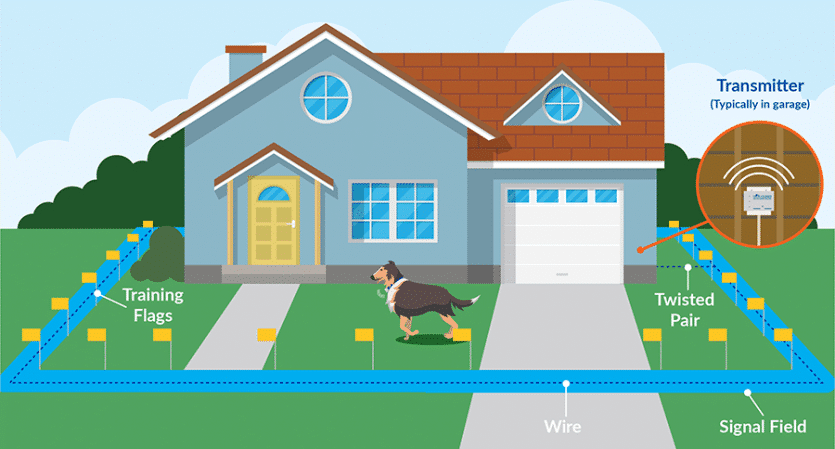
Dogs are prevented from crossing property boundaries to create an electrical discharge through a rechargeable collar by using wireless fences, which are affordable, customizable electrical barriers.
Here’s a breakdown of wireless dog fences, their pros and cons, and key takeaways to help you decide if they’re right for your situation.
What are Wireless Dog Fences?
- Invisible Boundary: Wireless fences create a circular boundary around a transmitter. The dog wears a special collar that emits warning beeps and, if ignored, a mild shock when they approach the boundary.
- Training is Key: Wireless fences aren’t magic. They require consistent training to teach your dog where they’re allowed to roam.
Pros of Wireless Dog Fences
- No Wires to Bury: Easier to install than traditional wired fences.
- Affordability: Can be cheaper than physical fences.
- Portability: Take them with you when traveling to keep your dog safe in new areas.
- Customizable: Adjust the boundary size to suit your property.
Cons of Wireless Dog Fences
- Limited Area: Only offer a circular boundary.
- Potential for Failure: Batteries can die, or signal disruption can occur, leading to the system failing.
- Not for All Dogs: Stubborn, pain-tolerant, or highly motivated dogs may break through the invisible barrier.
- Training Required: Success depends on consistent training.
- Pain-Based: The system relies on corrective shocks.
How to Choose a Wireless Dog Fence
- Reliability: Look for systems with good reviews and strong signals to avoid escapes.
- Collar Features: Adjustable correction levels, waterproof design, and battery life.
- Area Coverage: Choose a system that matches the size of your property.
- Your Dog: Factor in your dog’s breed, size, and temperament.
The Verdict: Should You Get One?
Wireless dog fences can be an option, BUT they have limitations and risks:
- Responsible Use: Only consider if you are committed to training and have a dog suitable for this type of containment.
- Not a Cure-All: Wireless fences won’t magically stop all escape attempts or replace proper supervision.
- Unpredictable Risks: Other animals or people can enter the boundary, potentially putting your dog at risk.
Key Takeaways
- They’re a Tool, Not a Solution: Success relies heavily on the owner’s training efforts and the dog’s individual response.
- Safety Considerations: Wireless fences may not deter determined dogs or prevent threats from entering your yard.
- Alternative Solutions: Depending on your situation, a physical fence, dedicated leash walks, or professional dog training might be a better fit.
Before Committing…
- Thorough Research: Get familiar with the limitations and potential downsides of wireless fences.
- Honest Assessment of Your Dog: Are they a good candidate for this type of system?
- Alternatives: Are there other ways to ensure your dog’s safety and freedom to exercise?
Remember: A wireless fence shouldn’t be your first or only choice for keeping your dog safe. Always prioritize their well-being and consider all options before making a decision.
What Is Wireless Dog Fence?
Electric fences rarely function by themselves. To teach your dog to remain in the yard, you must combine it with behavioral training. The better options, like the well-known invisible dog fence, actually include training as part of the cost.
Even while building a fence or tying them up makes some sense, an electric fence is not the best option.
You could be contemplating choices like an electric dog fence to prevent your dog from fornication and suffering if you recently moved into a home without a fenced yard or if you opted to adopt a dog when your home no longer has a fence to keep your dog on the property.
Because many cities have regulations against allowing dogs to go off-leash and because you don’t want your dog to get lost or killed, it is crucial to keep your dog on your property.
The issue is that traditional fences are frequently pricy, subject to local regulations, unsightly, and ineffective against dogs that may dig through or jump over them. You may be considering purchasing an invisible fence as a result.
Pros Of Wireless Dog Fence:

The practical benefits of wireless fences have already been appreciated by most conscientious pet owners who are concerned about the well-being and increased comfort of their own pets.
Cutting-edge gadgets of the new generation will form the basis of a well-functioning movement control mechanism within private houses, cottages, and mansions.
Do Not Require Cabling:
Unlike wired electric dog fences, wireless systems do not require cabling. It is enough to set flags along the desired perimeter, which will transmit a signal if the animal starts to approach them.
Convenient and Unpretentious:
Wireless systems are more convenient and unpretentious in operation. All that is required is to periodically charge the sensors. Remember, the animal should not wear a collar with a sensor for more than 12 hours, it is advisable to remove the collar at night.
You can take the wireless device with you to nature, on a trip and be sure that the animal will not be lost or lost in an unfamiliar place.
Easy To Install and Configure:
With the help of a connection, you can configure all parameters and boundaries. If necessary, you can transfer this system without any problems.
There is another important advantage that guarantees the safety and comfort of the pet while traveling.
You can take such a system with you camping if you go on vacation with your pet. On the spot, you can set it up and be sure that the dog will not run far from the camp, frightened of an unfamiliar place and unfamiliar smells.
Good For Large Dogs:
In fact, large dog breeds generally don’t like being restricted in their movement. The thing is that by nature these creatures are very curious, they need to check everything, learn new things, they willingly get acquainted with everything hitherto unknown.
So, an ordinary fence cannot always guarantee the reliability, safety, and convenience. In general, many large dogs quickly get used to it and can even jump over it and the owners themselves do not like to install fences as high as human height, as they are not always practical and convenient for them.
In addition, the design of the fence itself can also be damaged by pets who are not happy that it blocks their way to explore the world. Wireless fences allow you to pre-set the area around the house where the pet can move and play freely.
Cons Of Wireless Dog Fence:

There are serious drawbacks to invisible dog fences and many feel that the cons outweigh the pros. Here are a few reasons you might want to consider another option than an electric wireless dog fence.
Need Behavioral Training:
They need additional behavioral training so that the dogs know where the property lines are. This reduces the risk of them getting electrocuted.
The shock is painful.
You can’t get away from this, that. If the blow is not strong enough, it will not keep the dog from depriving the property. This is a form of punishment.
Can Stop Working:
Electrical failures can cause the fence to stop working and the batteries in the collar may not last. If this happens, your dog may stop at the property for convenience, or they may wander off when there are no consequences for doing so.
Wireless Fences Sometimes Break:
Particularly if they are not buried very deeply in the ground, wireless fences can occasionally collapse. If you can’t locate the breakdown, fixing them may require digging out significant portions of the fence.
Sometimes Fails To Control Strong Dogs:
Invisible fences are not physical barriers, and if the dog is strong enough, it can get through the pain and run, especially if there is something on the other side of the barricade that it cannot resist.
An electronic fence is a virtual border, so it should not be treated as a very reliable barrier for all breeds of dogs. Each dog is trained individually.
Therefore, the manufacturer does not guarantee that the dog will necessarily be in the area enclosed by the electronic fence under any circumstances.
How To Choose Wireless Dog Fence?

Here I am giving some tips to choose a wireless dog fence. This will also allow you to choose the features of the collar of the fence that would go best with your animal.
And the size of your garden will determine the length of your fence. You must also choose a collar whose autonomy corresponds to your availability.
Work-ability
The capacity to deal with thinner wire, such as 20-gauge, is its principal benefit. More flexible and user-friendly is thinner wire.
This is a crucial issue to take into account, particularly if you intend to create your own twisted wire sections or if you are laying your wire in an intricate design.
It is significantly simpler to twist and lay a thinner wire due to its flexibility. Although they may be more durable, thicker gauges are stiffer, making them potentially harder to work with.
Leash:
The dog leash that employs a GPS receiver is the next feature to look for in a fence. This will allow you to take the dog with you when you leave the house.
You will be able to notify your dog so that he knows when to come home. Your dog will be able to maintain the leash on you once he knows where you are, which is crucial so you can be confident that he is being taken care of.
Signal Transmission:
Unless you are utilizing a system at or close to its full rated capacity, the gauge of the electric dog fence wire you use won’t have much of an effect on how the wire carries the signal.
In this situation, a thicker cable might aid in extending the system’s range. For instance, by using a thicker wire, you might be able to extend a 20-acre system to enclose 22 acres.
Durability:
Between a 20 gauge and a 14 gauge, there is a significant difference in durability. The majority of pet fence system manufacturers use 20 gauge wire of inferior grade to package their systems.
As a result, the dog fences are far less expensive to freight and purchase initially than they would be if they used the heavier professional-grade dog fence wire.
Size and Weight Of Your Pet:
Before choosing a fence for your pet, it is necessary to take into account the size, the character of the latter as well as the surface of your garden. Indeed, the size of the animal determines the type of electric fence.
You must therefore check the weight and size of your pet in order to better choose the appropriate electrostatic shock. As for the character, it allows knowing if you need above all a training fence to educate your dog in the best conditions.
Other:
- The size and location of the property;
- Shape and type of landscape zone;
- Weight and age indicators of the dog;
- Characteristics and distinctive features of the breed.
In addition to the above factors, it is important to take into account the number of dogs, the level of water resistance, as well as resistance to mechanical environmental factors.
During the operation of the device, the wires are underground and provide a prompt supply of a harmless signal. The specific property of the fence lies in a proportionally pulsating stimulating effect. As the pet approaches the line, the intensity of influence increases.
Do not miss the unique opportunity to purchase wireless fences for dogs that will adequately cope with the role of fencing equipment.
How Does An Electric Dog Fence work?

How an electric dog fence works will depend on the system you have purchased. Whether wired or wireless, the mode of action will not be the same. This is why it will be important to think carefully about choosing the right product before purchasing an electric dog fence.
This system is equipped with a transmitter which must be placed in the center of an area. As soon as this is the case, the Receiver Collar should be placed on the dog.
This solution requires less work since there is no physical installation to speak of, as with the device mentioned above.
The transmitter only sends a circular radio signal. It is then that as soon as the dog approaches the area, it will receive a beep, then an electric shock.
The problem is that the dog will not really understand what is happening. The wire system has the advantage of having flags that make it possible to delimit an area.
It is easier to get the dog used to the electric fence and to prevent him from hurting himself too often by dint of approaching the limits of the electric fence.
In any case, it is an easy to set up-and effective mode. The modes of action are not the same, but the results are there. They will prevent the animal from running away.
How To Install Wireless Dog Fence?

Be aware that there are many installation solutions, the one we will explain to you below is the simplest and most generic of installations. The manufacturers provide you with an installation guide when you buy one of their products.
In the event of a problem with the layout of this device, we advise you to contact customer service. Of course, a branded anti-fugue system will allow you to obtain an answer more easily than with a low-cost brand.
Step 1: Transmitter Installation
Provide a place sheltered from heat and rain. This could be your garage or the room closest to the garden. Insist on this last point because interference between the transmitter and the rest of the system must be avoided as much as possible.
If you are using a wireless fence, be sure to position the box in the center of the circular boundary area. If it is a wire fence, just make sure that the access to connect it to the wire is not difficult. In both cases, there must be an electrical source next to the box since it must be powered with it.
Step 2: Equip Your Dog With The Collar
Once everything is in place, put the collar around your dog’s neck. When doing this, make sure the dog is comfortable and therefore the collar is not too tight.
If unfortunately, the collar is too tight, the dog will have difficulty breathing and therefore there will be a risk of suffocation. A collar that bothers the animal could stress it or easily irritate its neck. The opposite case is also to be banned.
A collar that is too wide is not comfortable at all. A shifting collar can also easily irritate the dog’s neck and cause injury. Moreover, he will be tempted to get rid of it as much as he can.
Step 3: Test It All
Once everything is in place, test everything before starting education with the anti-fugue collar. Attach a leash to your dog and lead him to the boundary zone. You will see if a beep sounds.
Then, adjust the correction to the minimum intensity possible and try to take your dog further. If he shows any responsiveness like straightening his ears or stopping or whatever, you’ll know to start correction on that intensity.
It is not because he does not obey immediately that he does not receive the direct order. Once all this is done, you are good and can start training with an anti-fugue collar.
Conclusion:
You can therefore adapt wireless electric fences for dogs, with antennae, and collars! It is practical and it is ideal to take full advantage of your pet and it is without prior authorization from the town hall. So take your pick and enjoy!

